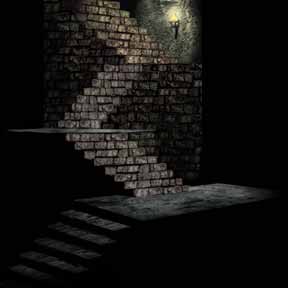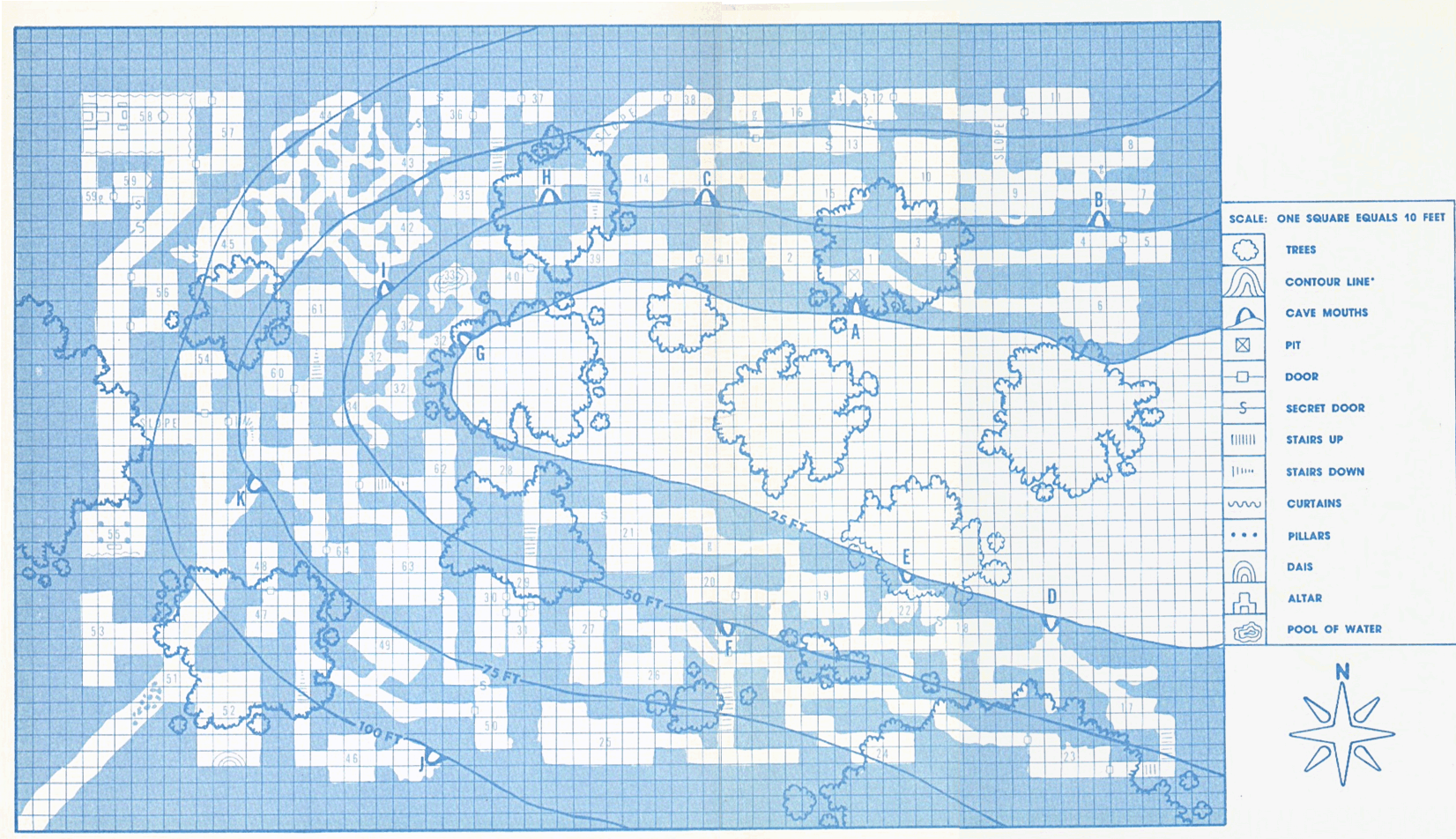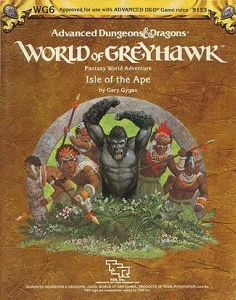 Classic Larry Elmore image, right? How many folks began their love of tabletop role-playing with this in front of them?
Classic Larry Elmore image, right? How many folks began their love of tabletop role-playing with this in front of them? My kids though?
R: "Dad, don't you think this guy is really unsmart? He's fighting a red dragon all by himself with no armor!"
L: "I know, right?"
No, no prompting here ... they've just learned that fire-breathing winged reptiles = bad news!
In our Homeguard Basic D&D campaign I've been surprised by just how much adventure we've managed to milk from the merely adequate Horror on the Hill ... though at its core, its just a basic four-level dungeon, we are going on ten months of play in that setting!
Short sessions have contributed to that because the week-long breaks between play give me plenty of time to allow the dungeon creeps to adjust their plans and placement based on the latest incursion into their subterranean domain. I will also say that trolls make sweet recurring villains ... especially for a level 1-2 party!
Here's what the gang has been up to over Christmas Break:
- The dragon dead, but Gideon's Fort partially burned, a group of characters had to go all the way to the town of Threshold to buy the supplies that they needed to recover the dragon hoard. While making this trek, first level fighter Blade was bitten when the party crossed paths with a pack of werewolves! Possessing neither silver, nor magic items (I'm a jerk like that), the party fled, sacrificing their beloved pack animals to the wolves. As his fellows set about recovering dragon gold and fighting off a rival adventuring party, Blade had to instead go to the Bishop of Threshold to seek relief from his curse of lycanthropy. Placed in the charge of PC cleric Sister Elizabeth, in exchange for his cure, Blade was loaned the magical, silver mace Moonhammer and sent to find and exterminate the growing pack of werewolves. A couple tense sessions featuring a farmhouse siege, an ambush, and a showdown in a windmill followed before the monsters were destroyed, some treasure was recovered and donated to grieving peasant families, and Moonhammer was returned to the vaults of the church.

- Newly promoted to the rank of Swordmaster (level three) after being scorched and scarred by dragonfire, doughty fighter Sarah chose to take a break from the wandering life of adventuring to accept an appointment to the duties of acting commandant of Gideon's Fort. This is the group's first little glimpse at the complex domain-management options offered by classic D&D. While Sarah hasn't been granted a barony, she is in charge of a small garrison and must try to use an (inadequate) budget to repair the wooden stronghold, replace slain men-at-arms, and provide all the necessary food and equipment.
- Star the elf and Jonathan the Hero (level 4 fighter) led a small expedition back to The Hill and ventured down into the goblin halls (level two) where the self-styled"Hobgoblin King" had held his court until being slain by Huey the elf in the recent Battle of Gideon's Fort. Over their many expeditions and clashes, close to two hundred of the wicked goblinfolk have been destroyed, so the halls below the ruined monastery were largely empty. Traps were discovered and bypassed, chests looted, a secret door found, and still more traps bypassed, with the end result being that the party finally got to loot the goblin treasury after months of raids, ambushes, and counter raids. They delivered the treasure into Sarah's keeping, helping her fund the reconstruction of the fort.
- Aareck (level 4 fighter) led a small expedition south in an effort to track down members of the Cult of the Dragon. Joining some pilgrims along the way, his group was ambushed by the cult and felled by Sleep Spells only to awake stripped of gear and shackled in a dungeon! I was cautious to give the false pilgrims a few "tells" (volunteering to take watch at night, being vague about the purpose of their travels, knowing that ranking dragon cult members wear purple robes when it came up, leading the characters to an established campsite off the beaten path, and sending a pair of their own out of the camp on some pretense shortly before nightfall) but the players never voiced their suspicions and were caught flat-footed. In the couple hours that followed we played The Great Escape chapter of module B9 Castle Caldwell and Beyond. Brute strength got the escape going along with a little bit of luck in finding some enemy gear. Rosie the 1st level fighter, despite a Charisma score of 6, succeeded in bluffing cult guards no less than three times. At one point the characters prepared a simple "trap" by wringing out saturated cloths in a dimly lit passage so their pursuers would slip and fall. By mid session the players developed a pretty good feel for the complicated layout of the place --I didn't allow any paper mapping since the characters didn't have any gear; they had to rely strictly on memory instead. As the cleric Kaylyn paused to smash a Dragon Queen idol (and was cursed by being struck dumb for her trouble) the party surprised me by intentionally fleeing deeper into the complex rather than escape when they had the chance! It turns out that they were unwilling to leave until they recovered Aareck's magic sword "Acris" (taken from the Keep on Shadowfell). Magic sword in hand (the only magic sword in this campaign so far) and informed of the cult's next target, the party finally fled into the hills with barely any equipment.
- Elsewhere, elves Lilybell and Soren along with a pair of halflings and Charlotte the second level magic-user began what they expected to be a long, eastward journey toward Elvenhome and the Grey Mountain in hopes of finding a way to bring their friend Sayana the elf back to life following her destruction by dragonfire. They knew that the connection between Elvenhome and their world to be tenuous and the path shifting and uncertain. What they didn't expect was to be met on the road by Thendara, a powerful immortal guardian from another realm. Thendara offered to help the adventurers reach Elvenhome if they would first rescue Princess Argenta from the cursed valley of Haven. They agreed (it really was an option) and they were off to explore B3 Palace of the Silver Princess (a scenario my younger player has been expressing an interest in playing for a while now).
So yeah ... we've been pretty busy over Christmas Break :)


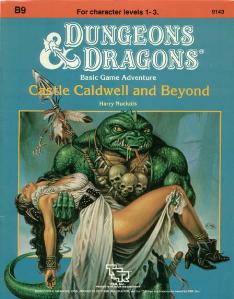
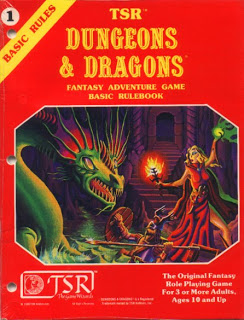
.jpg)


